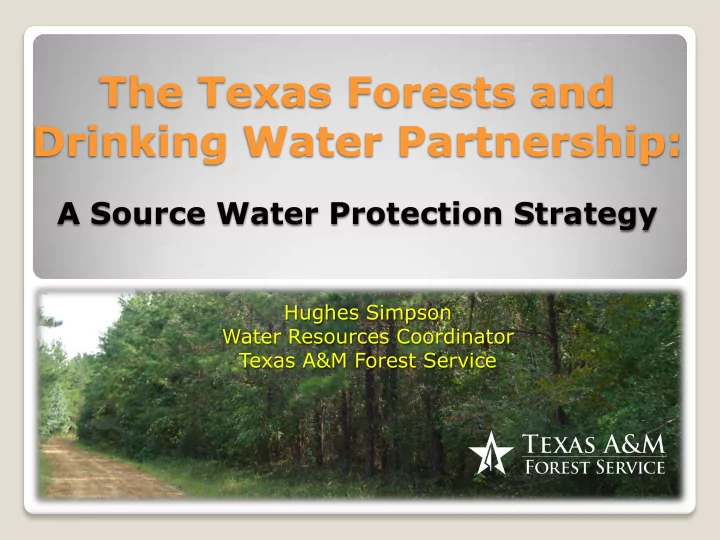

The Texas Forests and Drinking Water Partnership: A Source Water Protection Strategy Hughes Simpson Water Resources Coordinator Texas A&M Forest Service
Benefits of Source Water Protection $1 for source water protection saves $27 on water treatment (Winecki 2012) NYC filtration avoidance waiver - $2B in watershed vs projected $8B - $10B in treatment
2004 TPL and AWWA Study 27 water suppliers surveyed ◦ For every 10% in forest cover, treatment costs 20% ◦ 50 – 55% variation in treatment costs explained by % forest cover
Why Forests? Stable source of clean water Slows runoff / erosion / flooding Buffer against accidental spills Co-benefits
Forests can be Managed and Still Provide High Quality Water if BMPs are Used Developed in response to the 1972 Clean Water Act. Guidelines vary by state, research across the USA has shown that BMPs are effective BMPs have evolved over time; based on continual improvement
Why Collaborate? Both sectors work in natural resources Raw material comes from same source Interdependent Maintaining economic vitality
What Does a Successful Collaboration Look Like? • Utility personnel & forest landowners know each other, meet regularly • Forest lands are valued by utility & drinking water customers • Utility has dedicated funding for source water protection • Utility & forest land owners work together on priorities for conservation, restoration and BMP’s
Communities with Established Watershed Protection Revenue San Francisco, CA Utility base budget $50 million/ 10 years Providence, RI Denver, CO 3 cents/100 gallons 33 cents/month $1.5-2 million/year $3.3 million/year Little Rock, AR 45 cents/month Raleigh, NC ~$1 million/year 40 cents/month $2 million/year Flagstaff, AZ $25 per $250k home, $50 per San Antonio, TX $500k home, etc. 1/8 cent sales tax $10 million bond $90 million cap
Why aren’t all utilities jumping on the watershed protection “bandwagon”? That’s not my backyard
SE Partnership for Forestry and Water Quality Meeting Greenville, SC March 29, 2012 • Developed Partnership • Part time Coordinator • 4 state partnerships (AR, GA, SC, TX ) • Three in development (AL, FL, NC)
Texas Forests and Drinking Water Forum November 17-18, 2015 23 Forest Sector 25 Water Sector 4 TFS 4 TX Rural Water 7 NRCS 8 Water Utilities 4 USDAFS 6 River Authorities 2 US Endowment 3 TCEQ 1 Forest Landowner 1 EPA 1 SGSF 1 Cons. Groups 1 TFA 1 Local Gov. (HGAC) 1 SFASU 1 TWRI 1 Forest Industry 1 Cons. Group
Texas Forests and Drinking Water Partnership Goals -Increase awareness, understanding, and communication between sectors -Identify mutual interests, challenges, barriers, and opportunities for collaboration -Designate critical priority watersheds -Demonstrate forest / drinking water proof of concept through pilot project
Accomplishments Follow up Partnership meeting May 2016 Developed working groups to advance Partnership Strategic Partnerships Economics Communication Priority Watershed Assessment Targeted prescribed burn grant program to priority watersheds Presented at various meetings to increase awareness
Geospatial Watershed Assessment Parameters Public Surface Water Supply Watershed • Population Served • Forest Cover • Threatened (Conversion, Fire, Insects/Disease) • Existing Partnerships (Watershed Groups) •
Geospatial Watershed Assessment 3/6/2017 17
Targeting Conservation Programs FWS / TFS Partnership Financial assistance for Rx burning Enhance wildlife habitat / water resources Used priority watersheds from assessment
Next Steps Continue to build support for the Partnership Engage local watershed cooperators Identify / pursue funding mechanisms Implement pilot Forest / Drinking Water project
Contact Hughes Simpson Texas A&M Forest Service 200 Technology Way College Station, TX 77845 (979) 458-6630 hsimpson@tfs.tamu.edu
Recommend
More recommend